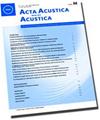Ultrasonic Study of Molecular Interactions in Polymeric Solution of Polypropylene Glycol-400 and Ethanol at 303 K
Q1 Arts and Humanities
引用次数: 4
Abstract
A comprehensive ultrasonic investigation of molecular interactions in the polymeric solution of polypropylene glycol (PPG)-400 and ethanol at 303 K has been performed using the data available in literature. Several acoustic parameters such as acoustic impedance, isothermal compressibility, molar sound velocity, molar adiabatic compressibility, internal pressure, free volume, van der Waals constants, molar cohesive energy and relaxation time have been explored. Thermo-dynamical parameters viz.: available volume, intermolecular free length, relative association, surface tension, pseudo-Gruneisen parameter, Debye temperature, diff usion constant, coefficient of thermal conductivity and latent heat of melting have been evaluated. Several thermo- elastic parameters such as Young modulus, shear modulus, bulk modulus and Poisson's ratio are also determined. Excess parameters are computed to study the relative molecular interactions and strength of interaction between the constituents of the polymer mixture. The volume expansivity data is used to evaluate Moelwyn-Hughes parameter, reduced volume, reduced isothermal bulk modulus, Sharma's constants, Huggins parameter, isobaric, isochoric, and isothermal lattice Gruneisen parameters, fractional free volume, repulsive exponent, Bayer's non-linear parameter, cohesive energy density and characteristic temperature. Schaaff 's collision factor theory, Jacobson's free length theory, Nomoto's relation, Van Dael-Vangeel relation, impedance dependence relation, Junjie relation and ideal mixing relation have been used to evaluate ultrasonic velocities in the system under study. The obtained results have been compared with earlier experimental results. The non-ideal behaviour of the mixture has been explained in terms of its composition and variation of its acoustical and thermo-dynamical parameters.聚丙烯-乙醇-400聚合物溶液中分子相互作用的超声研究
利用文献中的数据,对聚丙烯乙二醇(PPG)-400和乙醇的聚合物溶液在303 K下的分子相互作用进行了全面的超声波研究。研究了声阻抗、等温压缩率、摩尔声速、摩尔绝热压缩率、内压、自由体积、范德华常数、摩尔内聚能和弛豫时间等声学参数。热力学参数包括:有效体积、分子间自由长度、相对缔合、表面张力、伪gruneisen参数、德拜温度、扩散常数、导热系数和熔化潜热。确定了杨氏模量、剪切模量、体模量和泊松比等热弹性参数。计算了多余的参数,以研究聚合物混合物组分之间的相对分子相互作用和相互作用强度。体积膨胀率数据用于评估Moelwyn-Hughes参数、缩减体积、缩减等温体积模量、Sharma常数、Huggins参数、等压、等时和等温晶格Gruneisen参数、分数自由体积、排斥指数、Bayer非线性参数、内聚能密度和特征温度。采用Schaaff碰撞因子理论、Jacobson自由长度理论、Nomoto关系、Van Dael-Vangeel关系、阻抗依赖关系、Junjie关系和理想混合关系等方法对系统中的超声速度进行了评价。所得结果与先前的实验结果进行了比较。从混合物的组成及其声学和热力学参数的变化方面解释了混合物的非理想特性。
本文章由计算机程序翻译,如有差异,请以英文原文为准。
求助全文
约1分钟内获得全文
求助全文
来源期刊
CiteScore
2.60
自引率
0.00%
发文量
0
审稿时长
6.8 months
期刊介绍:
Cessation. Acta Acustica united with Acustica (Acta Acust united Ac), was published together with the European Acoustics Association (EAA). It was an international, peer-reviewed journal on acoustics. It published original articles on all subjects in the field of acoustics, such as
• General Linear Acoustics, • Nonlinear Acoustics, Macrosonics, • Aeroacoustics, • Atmospheric Sound, • Underwater Sound, • Ultrasonics, • Physical Acoustics, • Structural Acoustics, • Noise Control, • Active Control, • Environmental Noise, • Building Acoustics, • Room Acoustics, • Acoustic Materials and Metamaterials, • Audio Signal Processing and Transducers, • Computational and Numerical Acoustics, • Hearing, Audiology and Psychoacoustics, • Speech,
• Musical Acoustics, • Virtual Acoustics, • Auditory Quality of Systems, • Animal Bioacoustics, • History of Acoustics.

 求助内容:
求助内容: 应助结果提醒方式:
应助结果提醒方式:


